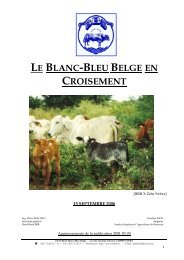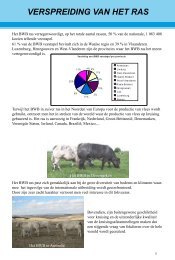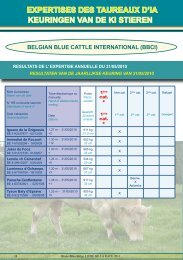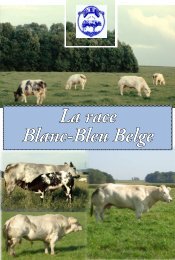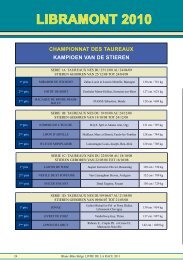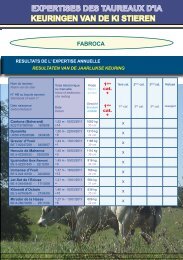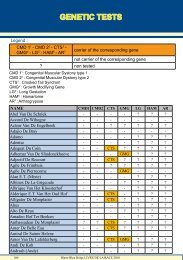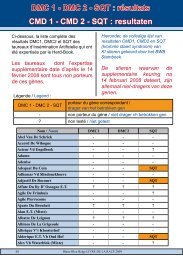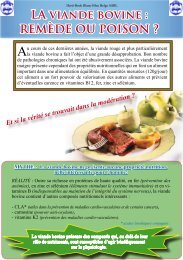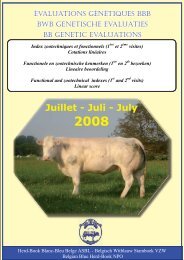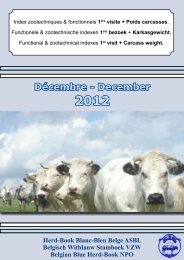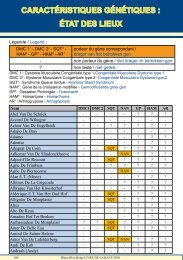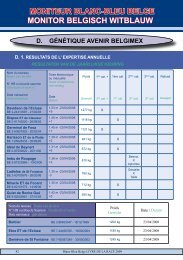10 Tips to Successful Crossbreeding - including Belgian Blue Beef
10 Tips to Successful Crossbreeding - including Belgian Blue Beef
10 Tips to Successful Crossbreeding - including Belgian Blue Beef
- No tags were found...
Create successful ePaper yourself
Turn your PDF publications into a flip-book with our unique Google optimized e-Paper software.
<strong>10</strong> tips <strong>to</strong> <strong>Successful</strong> <strong>Crossbreeding</strong>1. Choose <strong>Belgian</strong> <strong>Blue</strong>, Inra 95 or Charolais…The dairy farmer who doesn't want <strong>to</strong> raise beef breed cattle is interested in genetics forcommercial crossbreeding. He looks for ease of calving but also for a good meaty type andgood early muscling.To meet these conditions, the "Charolais Excellence", Inra 95 and <strong>Belgian</strong> <strong>Blue</strong> programsare interesting.These testing programs are intended <strong>to</strong> improve the ease of calving and the value of thecrossbred calves on sale.However, be careful with private bulls, even if they are of one of these three breeds: easycalving is not assured…2. Use low quality cows….Play the card of commercial crossbreeding with cows on which the genetic or the recordsdon't correspond <strong>to</strong> your breeding aims. But also on cows which are late in the AI seasonor on cows back in season after AI : We know that the fertility rate of the AI is higher incrossbreeding.3. Pick up the sires with good index…For Charolais, the sires of the "Excellence" program have a minimum of 84 for the ease ofcalving and a minimum of 111 for the early muscling. Choose the sires recorded <strong>10</strong>0 andmore for the ease of calving and 115 and more for the early muscling.For the Inra 95, the suggested sires have generally an index higher than <strong>10</strong>0 for the ease ofcalving : It's a real security. Then look for a good index for the meaty type (around <strong>10</strong>5-120).For the <strong>Belgian</strong> <strong>Blue</strong>, in Belgium, a specific crossbreeding program is being elaborated.The first calves are not yet born. The testing is being done for the purebred, so there is nodata for the ease of calving but an index for the birth weight. On the other hand, for themeaty type, take the best index: <strong>10</strong>5 and more.Details : these details are not always available in the catalogues of AI stations. Theysometimes translate in<strong>to</strong>: easy calving, very meaty calves.4. Are you beginner or experienced in crossbreeding ?…"When someone begins in crossbreeding, I advise <strong>to</strong> choose sires well-known for their easeof calving: Rossli, Mochet, Lucius, Polti. The calves are a bit lighter. Then, theexperienced crossbreeders, looking well after their cows, are able <strong>to</strong> use the champions ofthe meaty type: Ormeaux, Lanzac or Pomardo who is really successful on our area.Obviously, the prices are higher." advises Gérard GUILLEMIN, in charge of the program“Charolais Excellence”.
5. Bet on genetics according <strong>to</strong> the local market….In the South West of France, the Inra 95 crossbred cattle are really attractive. In Côtesd'Armor,they are particularly interested in <strong>Belgian</strong> <strong>Blue</strong> crossbreed cattle. In the center ofFrance, the buyers can't resist the Charolais crossed with Montbéliard cows. So it' s better<strong>to</strong> propose the locally requested product, a product that the buyers know and recognize forthe high value. The challenge of the terminal crossbreeding is, above all, economic.6. Favour white-coat sires…The dark-coat Inra 95 or <strong>Belgian</strong> <strong>Blue</strong> sires give a variable proportion of red and white,black and white or white and blue calves depending on the breed of the dam. These calvessometimes look exactly like dairy males. Their growth potential is excellent but becauseof their coat color, they don't give a good impression. So the buyers don't really feel likebuying them for their right value.Depending on the selection program, the data concerning the coat color of the offspring aresometimes available in the catalogues. For the Inra 95 and the Charolais this data is givenin percentage of one-color or light-color coat. For the <strong>Belgian</strong> blue, choose a white-coatsire.7. Manage the feeding during the drying-off of commercial cows…Even if the crossbreeding selection programs guarantee the security for the calving, don'ttake <strong>to</strong>o many risks. Be careful when you feed the dried-off cows with <strong>to</strong>o rich rations : atease in his mother and well-fed, the calf gets the gestation longer and doesn't forget <strong>to</strong> pu<strong>to</strong>n weight. " Before the birth, a calf can put on 800 g per day" confirms Eric FRANCOISfrom Genes Diffusion. A crossbred calf that is supposed <strong>to</strong> bear without any calvingtrouble can cause problems at calving if the ration isn't perfectly adapted. Be careful.8. Raise the calves <strong>to</strong> 3-weeks old…At birth, these champions of crossbreeding are small: an average weight of 40-45 kg.It doesn't impress a buyer, but these calves already have a great potential. After 3 weekson milk, they don't drink more than a dairy calf at the same age but their round shapeappears. The buyers can't ignore this meaty type any more. According <strong>to</strong> the area and themarkets on one side, and the type, the color and the quality of these animals on the otherside, they are sold between 300€ and 650€.9. Can we cross a heifer?It's up <strong>to</strong> the breeder. The Limousine with its small calves could do so but is it serious <strong>to</strong>cross a heifer since we don't even know the milk potential? It might be the future star ofthe herd and we could probably get good purebred daughters out of it…<strong>10</strong>. Don't confuse early muscling and meat quality.In the Charolais in particular, don't confuse “early muscling” that guarantees beautifulcrossbred cattle, sold at a few weeks and the “meat quality”, indicating an improvedproduction of s<strong>to</strong>re cattle, young bulls and steers.Translated from PLM Magazine French-language articlehttp://www.plm-magazine.com/croisement-industriel.htm.



